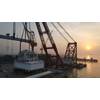SAL Fly High With New Extension
SAL Heavy Lift, a carrier specialized in sea transport of heavy lift and project cargo, has installed a Fly-Jib crane boom extension on MV Lone which will be used on an offshore wind project in Taiwan.
The Hamburg-based company said in a press release that the Fly-Jib extends the crane hook to the height of some 70 metres and can be installed to each of the main crane booms of SAL’s Type 183 vessels.
With the much greater lifting height and further outreach, SAL’s new Fly-Jib can meet clients demands when units become ever bigger and where one faces requirements to lift long components vertically – e.g. with offshore wind equipment. A challenge SAL faces just now with an offshore piling project.
Sune Thorleifsson, Head of Marine Projects, SAL said: “Our Fly-Jib has long been on our wish list, but when a client recently approached us with the requirement to support on driving piles into the seabed for an offshore wind project, and the piles being so long that it was otherwise not possible to up-end them for installation, we saw the opportunity to realise this long term dream”.
SAL Heavy Lift’s sister company SAL Engineering has worked intensively with crane maker TTS-NMF to design and develop a Fly-Jib that can suit a wide array of scopes, hence a dismountable and modular design was conceived.
Karsten Behrens, Director, SAL Engineering explained: "We worked for a long time on various designs together with TTS-NMF – the manufacturer of the cranes on our Type 183 vessels. It was essential that in addition to strong lifting capabilities, that it could be configurable in various modes hence adding to its applicability in various working scopes."
Karsten added: "Therefore, the Fly-Jib can be configured in a long (23m) or a short(13m) set-up and is adjustable in three different angles. It is designed to be interchangeable be-tween our Type 183 vessels and can, with modifications to the existing jib, be in-stalled on each of the cranes”.
The Fly-Jib is designed to withstand the forces occurring during a sea voyage and can be installed using only the vessels existing cranes.
Related News





